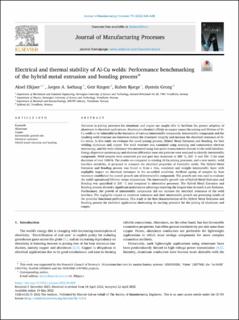| dc.contributor.author | Elkjær, Aksel Sean | |
| dc.contributor.author | Sørhaug, Jørgen A | |
| dc.contributor.author | Ringen, Geir | |
| dc.contributor.author | Bjørge, Ruben | |
| dc.contributor.author | Grong, Øystein | |
| dc.date.accessioned | 2022-12-13T09:03:34Z | |
| dc.date.available | 2022-12-13T09:03:34Z | |
| dc.date.created | 2022-08-30T09:58:11Z | |
| dc.date.issued | 2022 | |
| dc.identifier.citation | Journal of Manufacturing Processes. 2022, 79 626-638. | en_US |
| dc.identifier.issn | 1526-6125 | |
| dc.identifier.uri | https://hdl.handle.net/11250/3037402 | |
| dc.description.abstract | Advances in joining processes for aluminum and copper are sought after to facilitate the greater adoption of aluminum in electrical applications. Aluminum's chemical affinity to copper causes the joining and lifetime of Al-Cu welds to be vulnerable to the formation of various intermetallic compounds. Intermetallic compounds and the resulting weld structure are known to reduce the structural integrity and increase the electrical resistance of Al-Cu welds. In this study we evaluate the novel joining process, Hybrid Metal Extrusion and Bonding, for butt welding aluminum and copper. The weld structure was examined using scanning and transmission electron microscopy, and the weld resistance was measured using four-point measurements forecast to the weld interface. Energy dispersive spectroscopy and electron diffraction zone axis patterns were analysed to identify intermetallic compounds. Weld samples were examined pre and post heat treatment at 200 °C, 250 °C and 350 °C for total durations of over 1000 h. The results are compared to existing Al-Cu joining processes, and a new metric, weld interface resistivity, is proposed to compare the electrical properties of bimetallic welds. The Hybrid Metal Extrusion and Bonding process was found to form a thin, consistent and straight intermetallic layer with negligible impact on electrical resistance in the as-welded condition. Artificial ageing of samples by heat treatment established the overall growth rate of intermetallic compounds. The growth rate was used to evaluate the weld's operational lifetime versus temperature. The intermetallic growth rate of Hybrid Metal Extrusion and Bonding was quantified at 200 °C and compared to alternative processes. The Hybrid Metal Extrusion and Bonding process showed a significant performance advantage requiring the longest time to reach 2 μm thickness. Furthermore, the growth of intermetallic compounds did not increase the electrical resistance of the weld interface. The negligible impact on electrical resistance and slow intermetallic growth are promising results of the potential functional performance. This study is the first characterisation of the Hybrid Metal Extrusion and Bonding process for electrical applications showcasing its exciting potential for the joining of aluminum and copper. | en_US |
| dc.language.iso | eng | en_US |
| dc.publisher | Elsevier | en_US |
| dc.rights | Navngivelse 4.0 Internasjonal | * |
| dc.rights.uri | http://creativecommons.org/licenses/by/4.0/deed.no | * |
| dc.title | Electrical and thermal stability of Al-Cu welds: Performance benchmarking of the hybrid metal extrusion and bonding process | en_US |
| dc.title.alternative | Electrical and thermal stability of Al-Cu welds: Performance benchmarking of the hybrid metal extrusion and bonding process | en_US |
| dc.type | Peer reviewed | en_US |
| dc.type | Journal article | en_US |
| dc.description.version | publishedVersion | en_US |
| dc.source.pagenumber | 626-638 | en_US |
| dc.source.volume | 79 | en_US |
| dc.source.journal | Journal of Manufacturing Processes | en_US |
| dc.identifier.doi | 10.1016/j.jmapro.2022.04.029 | |
| dc.identifier.cristin | 2047032 | |
| cristin.ispublished | true | |
| cristin.fulltext | original | |
| cristin.qualitycode | 1 | |

